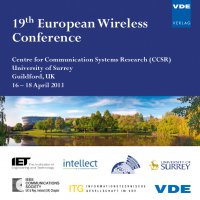Dual Analysis of the Capacity of Spectrum Sharing Cognitive Radio with MRC under Nakagami-m Fading
Konferenz: European Wireless 2013 - 19th European Wireless Conference
16.04.2013 - 18.04.2013 in Guildford, UK
Tagungsband: European Wireless 2013
Seiten: 6Sprache: EnglischTyp: PDF
Persönliche VDE-Mitglieder erhalten auf diesen Artikel 10% Rabatt
Autoren:
Oni, Phillip Babatunde; Duan, Ruifeng; Elmusrati, Mohammed (Communications and System Engineering Group, University of Vaasa, Vaasa, 65200, Finland)
Ajibesin, Adeyemi A. (School of Information Technology and Communication, American University of Nigeria, Yola, Nigeria)
Inhalt:
In this study, the maximum achievable information transmission rate of spectrum sharing cognitive radio with maximal ratio combining (MRC) antenna diversity technique is investigated when the channel between the secondary transmitter and the primary receiver, and that between the secondary transmitter and secondary receiver suffer Nakagami-m fading. With an assumption that both channels encounter Nakagami-m fading and the transmission of the secondary transmitter is subject to average interference power constraint, the approximated expressions for analyzing the effective capacity and the ergodic capacity of cognitive radio users with MRC are presented. The two capacity models are compared. In the case of effective capacity, it is shown that different applications or users with different quality of service (QoS) requirements can be supported in cognitive radio, and when the delay QoS decreases, the effective capacity approaches the ergodic capacity. Keywords — cognitve radio, effective capacity, ergodic capacity, Nakagami, maximal ratio combining


